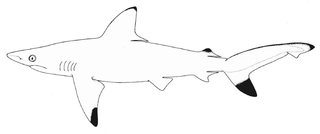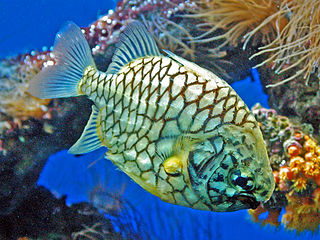
Mackerel is a common name applied to a number of different species of pelagic fish, mostly from the family Scombridae. They are found in both temperate and tropical seas, mostly living along the coast or offshore in the oceanic environment.

Anomalopidae are a family of fish distinguished by bioluminescent organs located underneath their eyes, for which they are named. These light organs contain luminous bacteria and can be "shut off" by the fish using either a dark lid or by being drawn into a pouch. They are used to communicate, attract prey, and evade predators.

The longspine snipefish, bellowfish, common bellowsfish, snipe-fish, snipefish, spine trumpet fish, or trumpetfish, Macroramphosus scolopax, is a snipefish of the genus Macroramphosus. It is also known as the slender snipefish off the South African coast.

The Pondicherry shark is an extremely rare species of requiem shark, in the family Carcharhinidae. A small and stocky gray shark, it grows not much longer than 1 m (3.3 ft) and has a fairly long, pointed snout. This species can be identified by the shape of its upper teeth, which are strongly serrated near the base and smooth-edged near the tip, and by its first dorsal fin, which is large with a long free rear tip. Furthermore, this shark has prominent black tips on its pectoral fins, second dorsal fin, and caudal fin lower lobe.

The quagga catshark is a species of catshark, belonging to the family Scyliorhinidae. A small, slim-bodied shark reaching 37 cm (15 in) in length, it has a distinctive color pattern of narrow, dark brown vertical bars, which resemble those of the quagga. Its head is short and flattened, with a pointed snout tip that is not upturned.

The cero, also known as the pintado, kingfish, cero mackerel, cerite or painted mackerel, is a ray-finned bony fish in the family Scombridae, better known as the mackerel family. More specifically, this fish is a member of the tribe Scomberomorini, the Spanish mackerels, and is the type species of the genus Scomberomorus. It is similar in appearance and coloration to the Atlantic Spanish mackerel, Scomberomorus maculatus, except the cero has a longitudinal stripe in addition to the spots of the Atlantic Spanish mackerel.

The pineapplefish also known as the Mailfish is a species of fish in the family Monocentridae, and the sole member of the genus Cleidopus. It is also known as the knightfish or the coat-of-mail fish, due to the armor-like scales covering its body, and the port-and-starboard light fish, as it has a pair of bioluminescent organs that are reminiscent of navigation lights on ships. Its specific epithet is from the Latin gloria and maris, meaning "glory of the sea".
Microsynodontis nasutus is a species of upside-down catfish endemic to Gabon where it occurs in the Ogowe River. It was first described in 2004 by Ng Heok Hee.
Coregonus bavaricus, the Ammersee kilch, is a species of freshwater whitefish endemic to Lake Ammersee in the German state of Upper Bavaria. A small, silver-colored fish, it typically lives between 60–85 m (197–279 ft) deep, though shallower in the summer months. In the early 20th century the Ammersee kilch was an important commercial species, but its population declined drastically in the 1930s onward due to overfishing and eutrophication of the only lake in which it is found. Today it is listed as Critically Endangered by the International Union for Conservation of Nature (IUCN) and may be on the verge of extinction.
Protemblemaria perla, the pearl blenny, is a species of chaenopsid blenny.

Exerpes asper, the Sargassum blenny, is a species of labrisomid blenny native to the Gulf of California and the Pacific coast of Baja California. According to Fishbase it is currently the only known member of its genus, however, the Catalog of Fishes classifies it within the genus Paraclinus.

The Gulf bareye tilefish, also known as the anchor tilefish, is a species of marine ray-finned fish, a tilefish belonging to the family Malacanthidae. It occurs in the western Atlantic Ocean.

Thunnus (Neothunnus) is a subgenus of ray-finned bony fishes in the Thunnini, or tuna, tribe. More specifically, Neothunnus is a subgenus of the genus Thunnus, also known as the "true tunas". Neothunnus is sometimes referred to as the yellowfin group, and comprises three species:

Thunnus (Thunnus) is a subgenus of ray-finned bony fishes in the Thunnini, or tuna, tribe. More specifically, Thunnus (Thunnus) is a subgenus of the genus Thunnus, also known as the "true tunas". Thunnus (Thunnus) is sometimes referred to as the bluefin group and comprises five species:

The streaked gurnard, also known as the African gurnard or rock gurnard, is a species of ray-finned fish belonging to the family Triglidae, the gurnards and sea robins. This fish is found in the eastern Atlantic Ocean and western Indian Ocean. This species is of commercial importance as a food fish.
The Panama spadefish is a species of marine ray-finned fish belonging to the family Ephippidae, the spadefishes. This species is found in the Pacific coast of the Americas from the Gulf of California to Peru. This species grows to a length of 30 centimetres (12 in) TL though most do not exceed 20 centimetres (7.9 in) TL. The Panama spadefishes is the only known member of the monospecific genus Parapsettus.

Iniistius pavo, the peacock wrasse or blue razorfish, is a species of marine ray-finned fish from the family Labridae, the wrasses, which has a wide Indo-Pacific distribution.
Choeroichthys latispinosus, also known as the Muiron Island pipefish or Muiron pipefish, is a species of pipefish native to the western coast of Western Australia, named for its recorded sighting on South Murion Island. It is thought to inhabit the area from Port Denison to Brecknock Island in the eastern Kimberley region.
Parmops coruscans is a species of flashlight fish native to the Pacific Ocean off the coast of Tahiti and from Fiji to French Polynesia. It is one of two species of Parmops along with P. echinatus, which was discovered off the coast of Fiji. Like other anomalopids, it is notable for the light organs underneath its eyes, which contain bioluminescent bacteria. To cover the organs, it rotates them down while sliding a black lid upward over each eye. The lack of development in its shutter mechanism helps place it between Anomalops and Phthanophaneron on the evolutionary tree.
The flashlight fish is a species of anomalopid fish of the order Beryciformes. It is native to the western Indian Ocean and the Red Sea where it is found near coral reefs. It is a nocturnal predator, hiding in crevices and caves by day and emerging to feed at night. At 11.0 cm (4.3 in) in length, it is small and relatively stout. Its body is mostly solid black, with the exception of white discoloration around its pectoral fins and a lateral line of reflective scales. It is most notable for the bioluminescent organs located underneath its eyes, which it uses to find prey, evade predators, and communicate with other members of its species. Like other Beryciformes, its reproduction is oviparous. It has no commercial value, and this combined with its timid, nocturnal nature makes population sizes and trends unknown. It is listed as Least Concern by the International Union for Conservation of Nature (IUCN) due to a wide distribution and lack of known threats.













